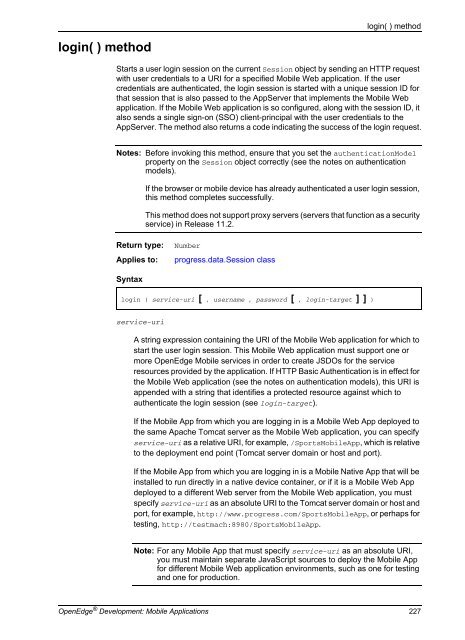OpenEdge Development: Mobile Applications - Product ...
OpenEdge Development: Mobile Applications - Product ...
OpenEdge Development: Mobile Applications - Product ...
You also want an ePaper? Increase the reach of your titles
YUMPU automatically turns print PDFs into web optimized ePapers that Google loves.
login( ) method<br />
login( ) method<br />
Starts a user login session on the current Session object by sending an HTTP request<br />
with user credentials to a URI for a specified <strong>Mobile</strong> Web application. If the user<br />
credentials are authenticated, the login session is started with a unique session ID for<br />
that session that is also passed to the AppServer that implements the <strong>Mobile</strong> Web<br />
application. If the <strong>Mobile</strong> Web application is so configured, along with the session ID, it<br />
also sends a single sign-on (SSO) client-principal with the user credentials to the<br />
AppServer. The method also returns a code indicating the success of the login request.<br />
Notes: Before invoking this method, ensure that you set the authenticationModel<br />
property on the Session object correctly (see the notes on authentication<br />
models).<br />
If the browser or mobile device has already authenticated a user login session,<br />
this method completes successfully.<br />
This method does not support proxy servers (servers that function as a security<br />
service) in Release 11.2.<br />
Return type: Number<br />
Applies to: progress.data.Session class<br />
Syntax<br />
login ( service-uri [ , username , password [ , login-target ] ] )<br />
service-uri<br />
A string expression containing the URI of the <strong>Mobile</strong> Web application for which to<br />
start the user login session. This <strong>Mobile</strong> Web application must support one or<br />
more <strong>OpenEdge</strong> <strong>Mobile</strong> services in order to create JSDOs for the service<br />
resources provided by the application. If HTTP Basic Authentication is in effect for<br />
the <strong>Mobile</strong> Web application (see the notes on authentication models), this URI is<br />
appended with a string that identifies a protected resource against which to<br />
authenticate the login session (see login-target).<br />
If the <strong>Mobile</strong> App from which you are logging in is a <strong>Mobile</strong> Web App deployed to<br />
the same Apache Tomcat server as the <strong>Mobile</strong> Web application, you can specify<br />
service-uri as a relative URI, for example, /Sports<strong>Mobile</strong>App, which is relative<br />
to the deployment end point (Tomcat server domain or host and port).<br />
If the <strong>Mobile</strong> App from which you are logging in is a <strong>Mobile</strong> Native App that will be<br />
installed to run directly in a native device container, or if it is a <strong>Mobile</strong> Web App<br />
deployed to a different Web server from the <strong>Mobile</strong> Web application, you must<br />
specify service-uri as an absolute URI to the Tomcat server domain or host and<br />
port, for example, http://www.progress.com/Sports<strong>Mobile</strong>App, or perhaps for<br />
testing, http://testmach:8980/Sports<strong>Mobile</strong>App.<br />
Note: For any <strong>Mobile</strong> App that must specify service-uri as an absolute URI,<br />
you must maintain separate JavaScript sources to deploy the <strong>Mobile</strong> App<br />
for different <strong>Mobile</strong> Web application environments, such as one for testing<br />
and one for production.<br />
<strong>OpenEdge</strong> ® <strong>Development</strong>: <strong>Mobile</strong> <strong>Applications</strong> 227
















